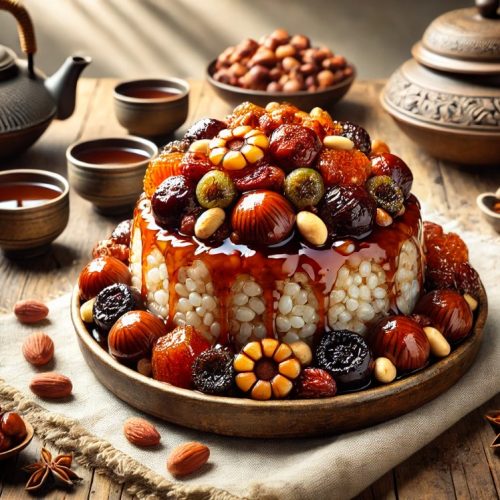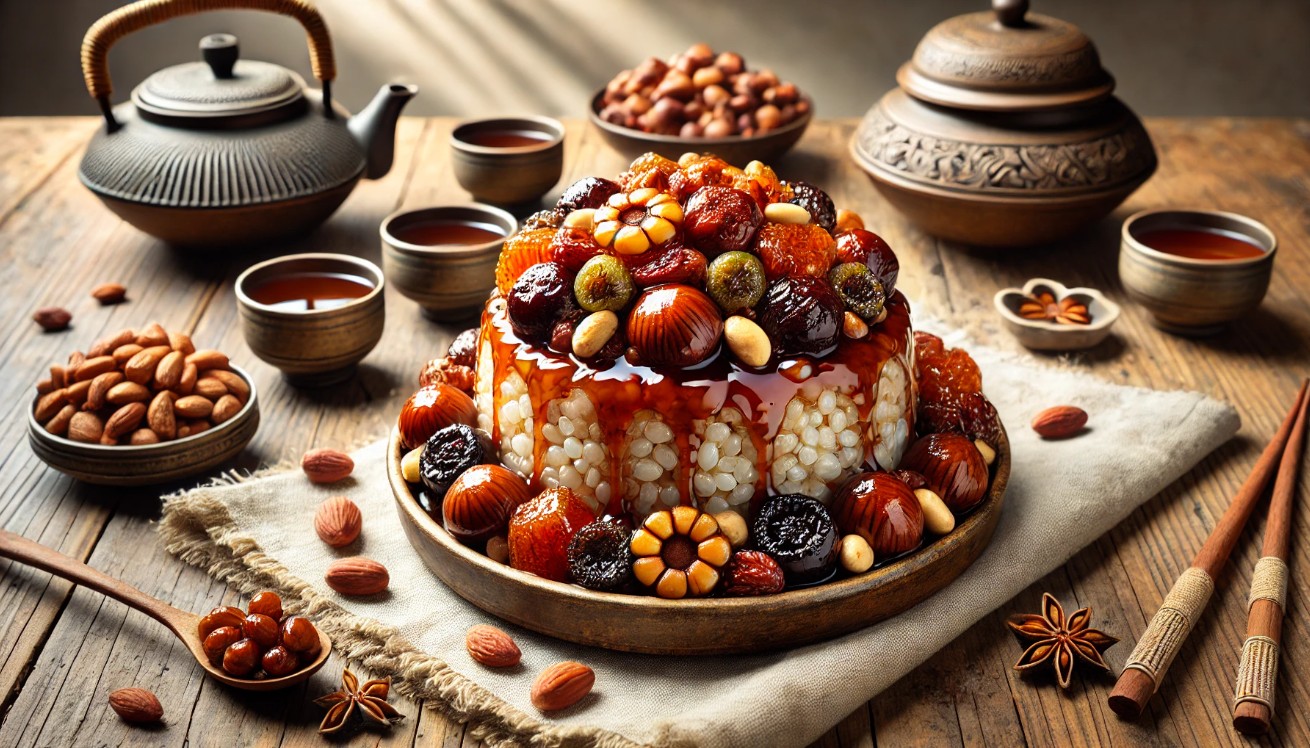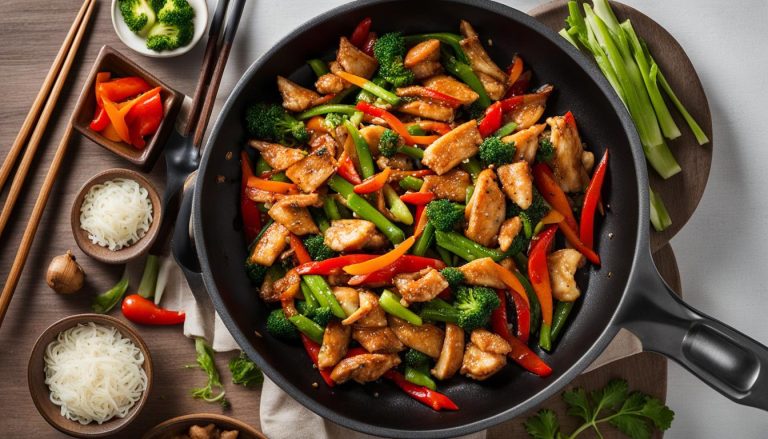Yaksik, also known as Yakbap, is a beloved traditional Korean dish with a history deeply intertwined with the country’s cultural and culinary heritage. This sweet rice dish, made from glutinous rice, dried fruits, and nuts, is sweetened with honey and brown sugar.
The name “Yaksik” translates to “medicinal food,” reflecting the historical belief in the health benefits of its ingredients, especially honey.
Over centuries, Yaksik has become an integral part of Korean celebrations, symbolizing festivity and nourishment. This article Yashik Recipe explores its ingredients, instruction, recipe variation and serving suggestions.
Why is Yaksik Recipe Famous?
Yaksik’s fame lies in its distinctive flavor profile and texture. It combines the chewiness of glutinous rice with the sweetness of honey and brown sugar, complemented by the earthy nuttiness of chestnuts and pine nuts and the fruity tang of dried jujubes and raisins.
This harmonious blend of flavors and textures makes Yaksik a delight for the palate.
Additionally, Yaksik’s reputation as a “medicinal food” has contributed to its popularity. Honey’s health benefits, including its anti-inflammatory and immune-boosting properties, were highly valued in traditional Korean medicine.
The inclusion of nutrient-rich ingredients like chestnuts and pine nuts adds to its wholesome appeal. Over time, Yaksik has transcended its medicinal connotations to become a cherished dessert and snack, enjoyed by Koreans of all ages.
Yaksik Recipe Ingredients

| Quantity | Ingredient |
| 2 cups | Glutinous Rice (short-grain sweet rice) |
| 1/4 cup | Dark Brown Sugar |
| 2 tablespoons | Soy Sauce |
| 1 tablespoon | Toasted Sesame Oil |
| 1 tablespoon | Honey |
| 1/2 teaspoon | Cinnamon Powder |
| 14-16 | Dried Jujubes (Korean Red Dates), rinsed, deseeded, and halved |
| 1/4 cup | Raisins |
| 2 tablespoons | Dried Cranberries (Optional) |
| 1/4 cup | Pine Nuts |
| 1 can | Chestnuts, drained and halved |
Yaksik Recipe Step-by-Step Preparation
Step 1: Prepare the Rice

- Rinse 2 cups of glutinous rice in cold water until the water runs clear to remove excess starch.
- Soak the rice in cold water for at least 5 hours. This step ensures the rice becomes soft and sticky when cooked.
- Drain the soaked rice thoroughly and set it aside.
Step 2: Prepare the Sauce

- Combine 1/4 cup dark brown sugar, 2 tablespoons soy sauce, 1 tablespoon toasted sesame oil, 1 tablespoon honey, and 1/2 teaspoon cinnamon powder in a bowl.
- Mix well until the sugar dissolves completely, creating a smooth and aromatic sauce.
Step 3: Prepare the Fruits and Nuts

- Rinse and deseed the dried jujubes, cutting them into halves.
- Drain the canned chestnuts and cut them into halves for uniform size.
- Remove the tips from the pine nuts to avoid bitterness.
- Combine the prepared jujubes, chestnuts, raisins, dried cranberries (if using), and pine nuts in a large bowl.
Step 4: Steam the Rice

- Line a steamer basket with a clean cotton cloth.
- Spread the drained rice evenly on the cloth in the steamer basket.
- Cover the rice with the edges of the cloth to prevent drying out.
- Add water to the steamer and bring it to a boil.
- Steam the rice over medium-high heat for 40 minutes. After 40 minutes, gently turn the rice with a wooden spoon to ensure even cooking.
- Continue steaming for an additional 20 minutes until the rice is fully cooked and sticky.
Step 5: Combine Rice with Sauce and Fruits/Nuts

- Transfer the steamed rice to the bowl containing the mixed fruits and nuts.
- Pour the prepared sauce over the rice mixture.
- Add an additional 1/4 cup of honey for extra sweetness.
- Mix thoroughly with a wooden spoon, ensuring all ingredients are well combined and the rice is evenly coated with the sauce.
Step 6: Final Steaming

- Return the combined mixture to the cloth-lined steamer basket.
- Cover with the cloth edges and steam over medium heat for an additional 30 minutes.
Step 7: Shape and Serve

- Remove the Yaksik from the steamer while still warm.
- Transfer the mixture into a lightly greased mold or baking dish, pressing it down firmly to ensure it holds its shape.
- Allow the Yaksik to cool to room temperature before inverting it onto a cutting board.
- Cut into desired shapes and sizes, such as squares or diamond patterns.
- Serve at room temperature or slightly chilled. Yaksik pairs wonderfully with traditional Korean teas like green tea or barley tea.
These variations allow you to adapt the traditional yaksik recipe to different occasions, tastepreferences, and dietary needs, making it a versatile and delightful treat!
Yaksik Recipe Variations

Yaksik, a traditional Korean sweet rice dessert, is a versatile dish that can be customized with various ingredients and flavors. Below are some creative ways to adapt and personalize the recipe to suit different tastes and occasions:
Sweetness and Flavor Adjustments
- Sweeter Version: Increase the amount of honey or dark brown sugar for a more indulgent sweetness.
- Mild Sweetness: Reduce the sweetness by using less sugar or opting for natural sweeteners like maple syrup, coconut sugar, or agave nectar.
- Flavor Enhancements: Add a splash of vanilla extract or a pinch of nutmeg to complement the cinnamon and bring a warm, aromatic depth to the dish.
Nuts and Fruits Substitutions
- Nut Options: Experiment with different nuts such as walnuts, almonds, or pecans for unique textures and flavors. Toasting the nuts before adding them enhances their nuttiness.
- Fruit Variations: Replace raisins or dried cranberries with dried apricots, mangoes, figs, or even candied orange peel for a new twist. For a more traditional touch, try dried persimmons (gotgam) or Chinese candied fruits.
Innovative Fusion Ideas
- Matcha Yaksik: Incorporate matcha (green tea powder) into the rice for an earthy, vibrant flavor and color.
- Chocolate Twist: Add cocoa powder or sprinkle chocolate chips into the mix for a decadent, modern dessert.
- Coconut Variation: Cook the glutinous rice with coconut milk instead of water, and garnish with shredded coconut for a tropical flair.
Texture Variations
- Sticky or Soft: Adjust the water-to-rice ratio to achieve a firmer or softer texture based on your preference.
- Chestnut Options: Use fresh roasted chestnuts instead of canned ones for a richer flavor and better texture.
Spices and Garnishes
- Additional Spices: Enhance the dish with ground cloves, allspice, or cardamom for a spiced dessert variation.
- Citrus Garnish: Add a sprinkle of orange or lemon zest for a refreshing hint of citrus that balances the sweetness.
- Sesame Seeds: Toasted sesame seeds sprinkled over the finished yaksik add a nutty aroma and visual appeal.
Shaping and Serving Ideas
- Bite-Sized Portions: Shape the yaksik into small balls, bars, or molds for individual servings—perfect for parties or gifting.
- Layered Dessert: Serve yaksik as a base layer in parfait glasses, topped with yogurt, whipped cream, or fresh fruit for an elegant presentation.
Dietary Modifications
- Gluten-Free Option: Ensure the soy sauce used is gluten-free, or substitute with tamari.
- Vegan-Friendly Version: Replace honey with plant-based alternatives such as agave nectar or maple syrup.
These creative variations allow you to reinvent yaksik to cater to diverse palates and dietary needs, all while preserving its delightful essence as a comforting and festive treat.
Yaksik Recipe Serving Suggestions

Yaksik, a sweet and aromatic Korean rice dish, can be served in a variety of ways to suit different occasions and preferences. Here are some creative and traditional serving ideas:
- Traditional Serving: Serve Yaksik in a large, shallow dish, allowing guests to scoop out portions. This style is ideal for family gatherings or festive occasions like Korean New Year (Seollal) and Chuseok.
- Individual Portions: For a more personalized touch, serve Yaksik in individual bowls or molded into small, bite-sized shapes using cookie cutters. This presentation is perfect for parties, buffets, or a casual meal.
- With Side Dishes: Yaksik pairs wonderfully with savory Korean side dishes (banchan) such as kimchi, pickled vegetables, or grilled fish. The balance between sweet and savory enhances the overall meal experience.
- As a Dessert: Yaksik can be served as a dessert at the end of a Korean meal. The richness of the sweet rice and fruits makes it a satisfying and comforting conclusion to the meal.
- Layered Parfait: For an elegant twist, serve Yaksik as a layered dessert in a glass. Layer it with whipped cream, yogurt, or even ice cream, and top with extra dried fruits or nuts for added texture and flavor.
- Tropical Touch: If you’ve infused the dish with tropical fruits or coconut milk, serve it in coconut shells or alongside fresh tropical fruit slices like pineapple, papaya, or mango for a tropical-themed meal.
- Tea Pairing: Pair Yaksik with a warm cup of traditional Korean tea, such as boricha tea or green tea, to complement the dish’s sweetness and enhance the dining experience.
Yaksik Recipe Nutrition Details Per Serving
| Nutrient | Amount per Serving |
| Calories | 270 kcal |
| Total Fat | 6 g |
| Saturated Fat | 1 g |
| Cholesterol | 0 mg |
| Sodium | 230 mg |
| Total Carbohydrate | 50 g |
| Dietary Fiber | 2 g |
| Sugars | 18 g |
| Protein | 4 g |
| Vitamin D | 0 mcg |
| Calcium | 40 mg |
| Iron | 1.2 mg |
| Potassium | 150 mg |
Conclusion
Yaksik is more than just a dish; it’s a culinary representation of Korea’s rich cultural heritage and traditions. Its unique combination of flavors, textures, and health benefits has ensured its enduring popularity.
Whether enjoyed during festive occasions or as a comforting snack, Yaksik continues to be a cherished part of Korean cuisine. By following this detailed recipe, you can bring a taste of Korea’s history and culture to your table.
Yaksik Recipe: Frequently Asked Questions (FAQs)
Why is Yaksik called “medicinal food”?
The name “Yaksik” means “medicinal food” because its ingredients, especially honey, were historically believed to have health benefits, such as boosting immunity.
Can I substitute glutinous rice with regular rice?
Glutinous rice is essential for its sticky texture. Using regular rice will result in a different texture.
Can I make Yaksik without honey?
Yes, you can substitute honey with maple syrup, agave nectar, or coconut sugar.
How long can Yaksik be stored?
Yaksik can be stored in the refrigerator for 3-4 days. Reheat by steaming or microwaving with a splash of water.
Can I adjust the sweetness level?
Yes, adjust the amount of honey and brown sugar to suit your taste. You can also use natural sweeteners for a milder sweetness.
Can I make Yaksik gluten-free?
Yes, use gluten-free soy sauce or tamari to make it gluten-free.
Can I use different fruits and nuts?
Yes, you can substitute dried jujubes, raisins, cranberries, and pine nuts with other fruits and nuts like apricots, figs, almonds, or walnuts.

Yaksik Recipe
Ingredients
- 2 cups Glutinous Rice short-grain sweet rice
- 1/4 cup Dark Brown Sugar
- 2 tablespoons Soy Sauce
- 1 tablespoon Toasted Sesame Oil
- 1 tablespoon Honey
- 1/2 teaspoon Cinnamon Powder
- 14-16 Dried Jujubes Korean Red Dates, rinsed, deseeded, and halved
- 1/4 cup Raisins
- 2 tablespoons Dried Cranberries Optional
- 1/4 cup Pine Nuts
- 1 can Chestnuts drained and halved
Instructions
- Rinse 2 cups of glutinous rice in cold water until the water runs clear to remove excess starch.
- Soak the rice in cold water for at least 5 hours. This step ensures the rice becomes soft and sticky when cooked.
- Drain the soaked rice thoroughly and set it aside.
- Combine 1/4 cup dark brown sugar, 2 tablespoons soy sauce, 1 tablespoon toasted sesame oil, 1 tablespoon honey, and 1/2 teaspoon cinnamon powder in a bowl.
- Mix well until the sugar dissolves completely, creating a smooth and aromatic sauce.
- Rinse and deseed the dried jujubes, cutting them into halves.
- Drain the canned chestnuts and cut them into halves for uniform size.
- Remove the tips from the pine nuts to avoid bitterness.
- Combine the prepared jujubes, chestnuts, raisins, dried cranberries (if using), and pine nuts in a large bowl.
- Line a steamer basket with a clean cotton cloth.
- Spread the drained rice evenly on the cloth in the steamer basket.
- Cover the rice with the edges of the cloth to prevent drying out.
- Add water to the steamer and bring it to a boil.
- Steam the rice over medium-high heat for 40 minutes. After 40 minutes, gently turn the rice with a wooden spoon to ensure even cooking.
- Continue steaming for an additional 20 minutes until the rice is fully cooked and sticky.
- Transfer the steamed rice to the bowl containing the mixed fruits and nuts.
- Pour the prepared sauce over the rice mixture.
- Add an additional 1/4 cup of honey for extra sweetness.
- Mix thoroughly with a wooden spoon, ensuring all ingredients are well combined and the rice is evenly coated with the sauce.
- Return the combined mixture to the cloth-lined steamer basket.
- Cover with the cloth edges and steam over medium heat for an additional 30 minutes.
- Remove the Yaksik from the steamer while still warm.
- Transfer the mixture into a lightly greased mold or baking dish, pressing it down firmly to ensure it holds its shape.
- Allow the Yaksik to cool to room temperature before inverting it onto a cutting board.
- Cut into desired shapes and sizes, such as squares or diamond patterns.
- Serve at room temperature or slightly chilled. Yaksik pairs wonderfully with traditional Korean teas like green tea or barley tea.









